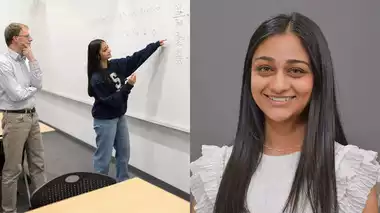In a groundbreaking achievement, Divya Tyagi, an Indian-origin student at Pennsylvania State University, has solved a 100-year-old mathematical puzzle related to aerodynamics. Her remarkable work has refined the theories of British aerodynamicist Hermann Glauert, paving the way for revolutionary advancements in wind energy technology.
The Young Genius Behind the Discovery
Divya Tyagi, currently pursuing her master’s degree in Aerospace Engineering at Pennsylvania State University, has made a significant contribution to the field of aerodynamics. By building upon and improving Glauert’s century-old research, she has introduced a more precise understanding of wind turbine efficiency, which could lead to groundbreaking developments in renewable energy.
Revisiting Glauert’s Model
Hermann Glauert, a renowned British scientist, had conducted pioneering research on the maximum energy output of wind turbines. However, his model primarily focused on enhancing energy generation without accounting for crucial aspects such as the forces exerted on the turbine blades or the impact of wind pressure, which can cause blade deformation.
Divya’s research has addressed these gaps, providing a refined solution that optimizes wind energy extraction while also considering structural integrity. Her findings have the potential to revolutionize the design and efficiency of next-generation wind turbines, making wind power more cost-effective and sustainable.
A Breakthrough in Wind Energy Science
Divya’s research has been published in the prestigious journal Wind Energy Science, highlighting the impact of her discovery on the global renewable energy sector. Her work is expected to play a crucial role in enhancing wind power generation efficiency, reducing costs, and improving the overall performance of wind turbines.
Praise from Experts and Advisors
Dr. Sven Schmitz, Divya’s research advisor at Pennsylvania State University, lauded her work, stating, “Her research could significantly influence the design and performance of future wind turbines worldwide. She has provided a much-needed solution to an age-old problem, which will help optimize wind energy harnessing and lower operational costs.”
Recognition and Awards
For her outstanding contribution to aerospace engineering, Divya Tyagi has been honored with the prestigious Anthony E. Wolk Award. This award is presented to students who excel in aerospace engineering research, and Divya’s achievement has placed her among the brightest minds in the field.
A Promising Future in Aerospace Engineering
Before embarking on her groundbreaking research, Divya completed her bachelor’s degree in Aerospace Engineering. She is currently engaged in Computational Fluid Dynamics (CFD) research, focusing on improving helicopter flight simulations and enhancing aviation safety. Additionally, she is working in collaboration with the United States Navy on projects aimed at refining aircraft performance and safety.
Global Impact of Her Discovery
Divya’s breakthrough is expected to have far-reaching implications beyond wind energy. Her refined aerodynamics model could be applied to various fields, including aviation, space exploration, and even high-speed transportation systems.
Her achievement serves as an inspiration to aspiring engineers and researchers worldwide, proving that young minds can solve even the most complex and long-standing scientific challenges.
Conclusion
Divya Tyagi’s success story is a testament to the power of perseverance, intelligence, and innovation. Her contribution to aerodynamics not only cements her place among the leading minds in aerospace engineering but also opens new doors for advancements in renewable energy. As the world moves towards sustainable solutions, her research stands as a beacon of hope for a greener future.


